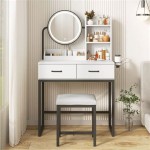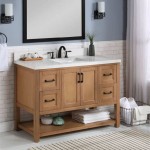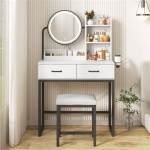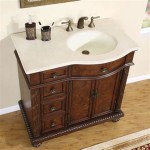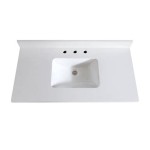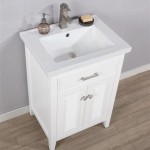How To Clean Carrara Marble Vanity Top
Carrara marble is a beautiful and luxurious material often chosen for vanity tops due to its elegant veining and classic aesthetic. However, marble is a porous stone, making it susceptible to staining and etching if not properly maintained. Understanding the proper cleaning techniques is crucial to preserving the beauty and longevity of a Carrara marble vanity top. This article provides a comprehensive guide on how to clean Carrara marble vanity tops effectively and safely.
Before embarking on any cleaning process, it is essential to understand the unique properties of Carrara marble. Marble is composed primarily of calcium carbonate, a substance that reacts readily with acidic substances. This sensitivity is what makes marble prone to etching, which is a dulling or roughening of the surface caused by acidic contact. Scratches are another concern, although marble is relatively soft and can be scratched by abrasive cleaners or harsh scrubbing tools.
Therefore, the guiding principle in cleaning Carrara marble is to use gentle, pH-neutral cleaners and soft, non-abrasive tools. Avoid anything acidic, alkaline, or abrasive. This approach will help prevent damage and maintain the pristine appearance of the marble.
Key Point 1: Daily and Weekly Cleaning Routine
Establishing a regular cleaning routine is the best way to prevent stains from setting and keep your Carrara marble vanity top looking its best. A simple daily wipe-down and a more thorough weekly cleaning will significantly reduce the risk of damage.
Daily Wipe-Down: After each use, wipe down the vanity top with a soft, damp cloth. This simple step removes spills, toothpaste, soap residue, and other everyday messes before they have a chance to dry and potentially stain the marble. Use lukewarm water and ensure the cloth is clean. Avoid using excessive water, as prolonged dampness can also be detrimental. Pay particular attention to areas around the sink and faucet, where water tends to accumulate.
Weekly Cleaning: Once a week, perform a more thorough cleaning using a pH-neutral marble cleaner. These specialized cleaners are formulated to gently remove dirt and grime without damaging the marble surface. Dilute the cleaner according to the manufacturer's instructions. Apply the diluted cleaner to the vanity top with a soft sponge or microfiber cloth. Gently wipe the entire surface, paying attention to any areas with noticeable stains or buildup. After wiping, rinse the vanity top thoroughly with clean, lukewarm water. Use a separate clean cloth to dry the surface completely. This prevents water spots and streaks.
For stubborn stains, consider making a paste of baking soda and water. Apply the paste to the stain, let it sit for a few minutes, and then gently wipe it away with a damp cloth. Rinse thoroughly with water and dry the surface. However, prolonged contact with baking soda should be avoided, as it can be mildly abrasive over time. Spot-testing this method on an inconspicuous area is always recommended before applying it to a larger area.
Avoid using generic household cleaners, as many of these contain acidic or alkaline ingredients that can damage marble. This includes cleaners containing lemon, vinegar, bleach, ammonia, or scouring powders. These substances will etch or scratch the marble surface, leading to irreversible damage. Always read the labels of cleaning products carefully before using them on your Carrara marble vanity top.
Proper ventilation is also important during cleaning. Open a window or turn on the exhaust fan to ensure adequate airflow. This is especially important when using any cleaning products, even those specifically designed for marble.
Key Point 2: Addressing Stains and Spills Promptly
The key to preventing permanent staining on Carrara marble is to address spills and stains immediately. The longer a spill sits on the surface, the greater the chance it will penetrate the marble and cause a lasting stain.
Immediate Spill Response: As soon as a spill occurs, blot it up immediately with a clean, dry cloth or paper towel. Avoid wiping, as this can spread the spill and make it more difficult to remove. Press down firmly to absorb as much of the liquid as possible. The type of liquid spilled will influence the next course of action.
Common Stain Removals: For water-based spills like juice, coffee, or tea, blotting is often sufficient. Follow up with a damp cloth to remove any remaining residue. For oil-based spills like makeup or lotions, blot the area with a clean cloth and then apply a small amount of pH-neutral dish soap to a damp sponge. Gently wipe the stain, rinse thoroughly with water, and dry the surface.
For tougher stains, such as those caused by hair dye or nail polish remover, specialized stain removers for marble may be necessary. These products are formulated to lift stains without damaging the marble surface. Follow the manufacturer's instructions carefully when using these products. Spot-test in an inconspicuous area before applying to the visible stain. In some cases, professional marble restoration may be required to remove deeply embedded stains.
Poultice Method: For particularly stubborn stains, a poultice can be used. A poultice is a paste-like mixture that draws the stain out of the marble. Different poultices are effective for different types of stains. For example, a baking soda and water poultice can be used for organic stains, while a diatomaceous earth and hydrogen peroxide poultice can be used for oil-based stains. Apply the poultice to the stain, cover it with plastic wrap, and let it sit for 24-48 hours. The poultice will absorb the stain. Remove the plastic wrap and allow the poultice to dry completely. Scrape off the dried poultice with a plastic scraper, rinse the area thoroughly with water, and dry the surface.
It is crucial to identify the type of stain before attempting to remove it. Using the wrong cleaning method can worsen the stain or damage the marble. If you are unsure of the best way to remove a particular stain, consult a professional marble cleaner or restoration specialist.
Key Point 3: Protection and Prevention
Preventing stains and damage is just as important as cleaning. Taking proactive steps to protect your Carrara marble vanity top will significantly reduce the need for intensive cleaning and maintenance.
Sealing: Sealing your Carrara marble provides a protective barrier that helps prevent stains from penetrating the surface. Marble sealers are designed to fill the pores of the stone, making it less absorbent. The frequency with which you should seal your marble depends on the type of sealer used and the level of use the vanity top receives. Generally, resealing every 6-12 months is recommended. Follow the manufacturer's instructions carefully when applying the sealer. Ensure the surface is clean and dry before applying the sealer. Apply the sealer evenly and allow it to cure completely before using the vanity top.
Mats and Trays: Use mats and trays to protect the marble surface from spills and scratches. Place a mat under frequently used items such as soap dispensers, toothbrush holders, and makeup organizers. This will help prevent these items from scratching or staining the marble. Use a tray to contain spills from toiletries and cosmetics. Choose trays that are made of non-abrasive materials such as felt or cork.
Avoid Placing Hot Items Directly on the Surface: Marble is susceptible to thermal shock, which can cause it to crack or discolor. Avoid placing hot items, such as curling irons or hair dryers, directly on the vanity top. Use a heat-resistant mat or trivet to protect the surface.
Avoid Abrasive Cleaners or Tools: Never use abrasive cleaners or tools on your Carrara marble vanity top. This includes scouring pads, steel wool, and abrasive powders. These materials will scratch the surface and dull the finish. Use only soft, non-abrasive cloths and sponges for cleaning.
Protect from Scratches: Be mindful of items that can scratch the marble surface, such as jewelry, metal objects, and abrasive containers. Avoid dragging these items across the vanity top. Place a soft cloth or mat under these items to protect the marble. Consider using felt pads on the bottom of objects that are frequently placed on the vanity top.
Regular Inspection: Regularly inspect your Carrara marble vanity top for any signs of damage or staining. Addressing problems early can prevent them from becoming more severe. If you notice any cracks, chips, or stains, consult a professional marble restorer as soon as possible.
By following these cleaning and protection tips, you can keep your Carrara marble vanity top looking beautiful for years to come. Regular maintenance and prompt attention to spills and stains are essential for preserving the elegance and value of this luxurious material.

How To Clean Carrara Marble An Easy Follow Care Guide

How To Clean Marble Countertops News

Remove Water Stains On Carrara Marble

The Pros Cons Of Marble Countertops What I Use To Clean Mine Zdesign At Home

How To Clean And Maintain Quartz Marble Vanity Tops

How To Clean Marble In Your Bathroom Unique Vanities

The Pros Cons Of Marble Countertops What I Use To Clean Mine Zdesign At Home

How To Clean Carrara Marble An Easy Follow Care Guide

How To Clean And Maintain A Granite Or Marble Top Bathroom Vanity Chans Furniture

How To Clean And Re A Marble Countertop
